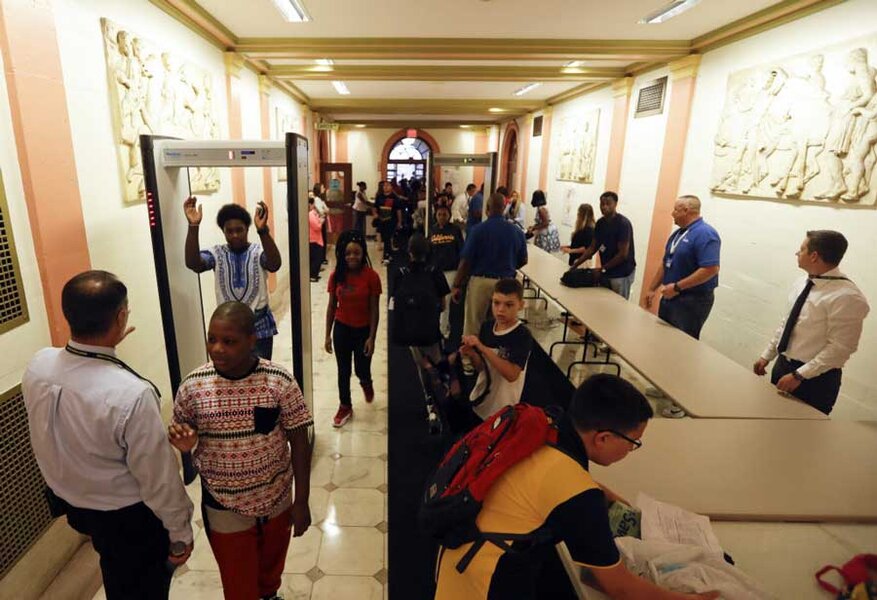When a high school seems like a prison
Loading...
Nosym Tillmon methodically removes his shoes, his belt, the liquids from his bag, and hands his phone to security guards. Then he waits for his turn to walk through the metal detector.
It might sound like he’s about to board a flight, but for the 11th-grader, this has none of the excitement of a vacation ritual. Instead, it’s part of the daily pre-7:30 a.m. routine to get to class at a public high school in Rochester, N.Y. It’s an experience he says can be summed up in one word: “prison.”
“Instead of making it feel like a safe environment, a home environment, it’s more of a ‘Jeez-why’ve-I-gotta-get-up-and-go-here’ environment,” Nosym says.
The 16-year-old would like to see the security hardware exchanged for more school counselors and more patient teachers.
His mother, Monica Bain, disagrees. She says that while she might feel similarly if she were a student, she “loves” the metal detectors. They give her peace of mind about the safety of her son and two younger daughters, who attend the same school in a city where the murder rate is more than triple the national average.
Nosym and his mom in many ways summarize both sides of the equation experts say school administrators must weigh to keep schools both safe and conducive to learning. But a recent study also found that school districts are far more likely to employ intense surveillance measures at public schools with high percentages of children of color, like Nosym’s – and that implicit bias may play a role in deciding where to employ such measures.
According to the findings by Jason Nance, an associate professor of law at the University of Florida’s Levin College of Law, Nosym is not the only student who feels like he’s being treated like a criminal when he shows up for class. And research shows those feelings of being under siege at school are hampering students’ sense of safety and trust, and affecting their learning.
Following the high-profile 2012 shootings at Sandy Hook Elementary School in Newtown, Conn., school security experts say there has been a nationwide spike of investment in visible security measures such as metal detectors, surveillance cameras, and school resource officers (SROs). While they don’t downplay the fact these come from a sincere desire to keep children safe, the weight of evidence, experts say, suggests the most effective forms of security are often more invisible.
Many parents advocate for the ‘no-nonsense’ hardware approach, which is often accompanied by a zero-tolerance disciplinary climate that studies have shown disproportionately affect students of color. But others argue such measures create a harsh climate for students, whose social-emotional well-being and learning would be better served by stronger relationships, along with funding for more teacher training and counselors.
One long-time school safety consultant says the security debate has been hijacked at the political extremes by, among others, hard-lobbying security hardware manufacturers at one end, and civil rights activists at the other.
“When you start politicizing school safety, as has been increasingly done in the last two decades … it only harms the best practices,” says Ken Trump, an independent school security consultant for 30 years. “That pendulum always seems to swing in our politics from one extreme to the other, and rarely does it rest in between, where really we need to be.”
Tech needs to be mixed with trust
Mr. Trump says a mixture of “hardware and 'heartware' ” is needed. Metal detectors and cameras can be useful – if maintained. But the gear is only as good as the relationships between adult staff and students, he says. If a weapon makes it into school, it is often other students telling a trusted adult that ultimately prevents a worst-case scenario. Staff and students properly trained in emergency response also can make a big difference.
The data on exactly how many millions of dollars schools have spent on camera systems, metal detectors, and security officers is as patchy as the evidence of their effectiveness. However, there is broad consensus among security experts that while overall violence in schools has declined dramatically in the past 25 years, public fear has grown because of horrific incidents such as Sandy Hook and the 1999 shooting at Columbine High School in Littleton, Colo. – a school that had metal detectors and SROs. The number of students who were victims of crimes at school dropped 82 percent between 1992 and 2014, according to The Atlantic, mirroring an overall drop in crime during in the United States during the same time period.
The Post-Sandy Hook hardware installation disproportionately occurred in schools with a majority student-of-color populations, according to Professor Nance’s research. That’s even though 62 percent of major acts of school violence in the past 2-1/2 decades were committed at majority white schools.
Nance found that schools with 50 percent or more of students of color were anywhere between two and 18 times more likely to use a combination of metal detectors, random sweeps, locked gates, and security guards than schools where 80 percent of students were white.
Nosym, who is part of a predominantly black youth social change organization, Teen Empowerment, was so keen to get out of his high school that he is graduating one year early. He will be one of the first in his family to attend college. He says many of his peers also want to leave. But for many, early enrollment in college isn’t an option.
“That’s why kids drop out and don’t wanna go back.... These guys are just setting us up for that – what do they call it? – The school-to-prison pipeline,” he says.
Nance and other researchers say there is some evidence to suggest that the presence of hardware and SROs does harm. In the worst cases, such research suggests hard measures can increase hostility, fear, and mistrust in schools, destabilizing the environment.
For example, security cameras may not deter bad behavior, so much as cause it to move elsewhere. For many children in high-crime areas, visible security can increase a desire for self-protection. Bain says she knows of elementary school children in her neighborhood that carry "little knives" on them because they're fearful.
Pepper-spray and handcuffs in the halls
Furthermore, many say, incidents that used to be handled by teachers and principals are now turned over to police.
Rosalyn Huff, who is black, and Allie Monck, who is white, both graduated this summer from a majority black and Hispanic high school in a north side neighborhood of Lexington, Ky. Overall, they say student relationships with SROs were good, but they were disturbed by incidents they regarded as unnecessarily heavy-handed.
Ms. Huff recalls how school police used to break up fights using pepper spray. It would hang in the air, affecting kids who weren’t involved. She says the practice lessened when a new principal came in. Another time, she remembers seeing a compliant 14-year-old boy being marched by SROs to the front office in handcuffs.
Ms. Monck recalls instances where a group of disruptive white students were verbally reprimanded, while disruptive students of color were ejected from the class.
Disproportionate punishment of minority students, Nance says, creates the kind of climate that has fueled strained relations between blacks and police across the nation.
What would make students feel safe?
So what would make schools feel safer?
Bain, Nosym’s mother, says she has good relationships with both SROs and the mostly-white teacher workforce at her children’s school, but thinks there's room for teachers to be more understanding.
“Patient, loving teachers … who aren’t so quick to yell or embarrass,” Bain says. Ones that take “the time to understand that all children are not the same. Some children don’t eat before they come to school, they’re starving, some kids got beat right before they came to school, some kids didn’t see their parents before they came to school.”
Nance, who in the 1990s taught at a school in Houston that had sniffer dogs and metal detectors, says there is a need to reallocate security funds toward teacher support and training in areas like classroom management – things research already shows they want.
“Teachers can minimize behavior problems before they start by simply learning how to engage students better,” Nance says. He adds that there are initiatives that have been shown to make schools both safer and more successful when it comes to disciplining students.
For example, Positive Behaviors, Interventions, and Supports – which includes the modeling, teaching, and practice of ethical behavior – has already been introduced in thousands of schools. Restorative justice programs have been shown to improve grades and reduce dropouts. These programs work to reintegrate offending students into the school community, as opposed to punitive measures like suspension that often lead to recidivism.
Nosym echoes Nance when asked what would make him feel truly safe in school:
“People need to come to school like, 'This is a breath of fresh air,' ” he says. “Come in here, everybody gonna smile, anything goin’ wrong or anybody feeling bad, there’s somebody right there to talk to them ... I would love that school.”






